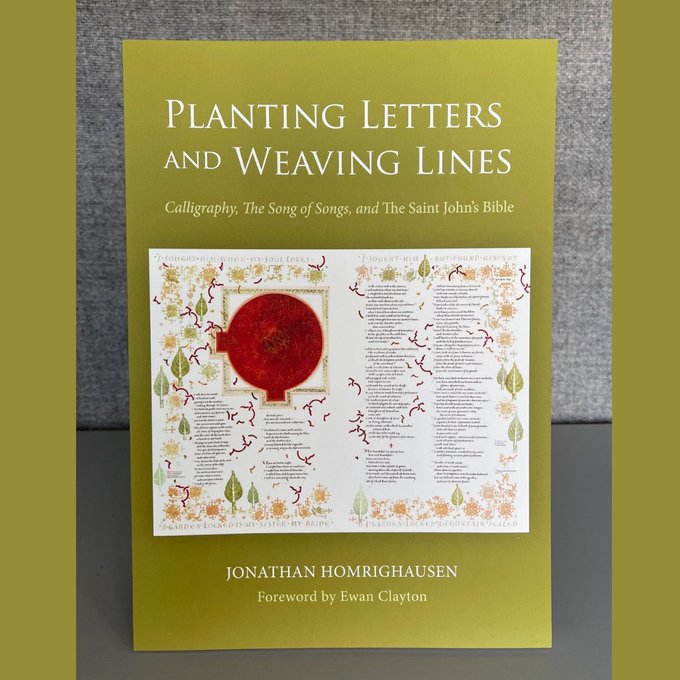
By Tim Walch
Book Review
A Review of “Planting Letters and Weaving Lines: Calligraphy, The Song of Songs, and The St. John’s Bible.” By Jonathan Homrighausen. Liturgical Press, 2022. 164 pages, $29.95

“In the beginning was the Word and the Word was with God, and the Word was God.” So begins the Gospel of John with a sentence that captures the centrality of the Bible in our lives. For Christians and Jews, that book is the sacred text of our lives. The Word as read, heard and even sung, inspires us and gives us direction.
Not surprisingly, the very effort to capture the majesty of God on pages and in volumes has captured the imagination of calligraphers, printers and artists for centuries. How can we do justice in a visual, tactile form to the miracle of the Word?
The Benedictine monks at St. John’s University embraced that challenge when they commissioned the first handwritten Bible in more than 500 years. Work began in 1998 and was completed in 2011 at a cost of $8 million. This project was led by master calligrapher Donald Jackson and a team of nearly two dozen specialists.
To say that the St. John’s Bible is a thing of beauty is an understatement. Written with quill pens on vellum pages, it uses the New Revised Standard Version Catholic Edition for its text. When open, the seven magnificent volumes are two feet tall and three feet wide and include 160 exquisite illustrations.
No review can capture the majesty of this work, but interested readers can view it online at: https://saintjohnsbible.org/See/Explore_Book. You can see it in person at St. John’s University in Collegeville, Minnesota.
The completion of this project spurred scholars and artists to study how the Word of God can be expressed in new ways. Among those who have stepped forward is Jonathan Homrighausen, a doctoral candidate at Duke University and a faculty member at the College of William and Mary. He’s spent years working with the St. John’s Bible and has shared his thoughts in several scholarly publications.
In “Planting Letters and Weaving Lines,” Homrighausen focuses on the Song of Songs by concentrating on how calligraphy and image interplay to give us a new understanding of the majesty of the text. “My premise,” he writes, “is that the power of calligraphic art lies in its ability to form connections between content, form, and process.”
To help the reader better understand his premise, Homrighausen uses a variety of metaphors as manifested in the poetry of the text. “Each chapter of this book unpacks a different metaphor for calligraphic art,” he notes, “such as weaving lines and planting letters. In these metaphors, the form and the process of the writing are entangled with the Holy Writ.”
The foremost metaphor is the garden. “If we view the page as a garden and the process of writing it as planting and plowing,” he adds, “we gain insight into the beauty of calligraphic art. Like a garden, every page of the St. John’s Bible, balances human order with chaos.”
Another metaphor is pilgrimage. Homrighausen encourages readers to think of turning pages as a walk — a slow walk — through these exceptional songs. We see, we read, we ponder along the way. “Both the pilgrimage of the hand and the pilgrimages of the eye suggest many other journeys,” he adds, “journeys to God, sometimes from God; journeys to make meaning with Scripture.”
A third metaphor that merits special mention is weaving. “Weaving has long served as a metaphor for composing song and text,” Homrighausen observes. “In all of these cases, the metaphor refers primarily to the craft of joining words together syntactically, not the material, physical labor of writing.”
“Planting Letters and Weaving Lines” will be of interest to anyone curious about the power of the Word and the beauty of the book. “It is a great garden to get lost in,” adds the author, “a wonderful labyrinth to lope through.” It’s a journey that provides pilgrims with a new portal to prayer.
(Timothy Walch is a lay director at St. Thomas More Parish in Coralville and a member of The Catholic Messenger Board of directors. He regularly reviews books for the Messenger and other publications and is the author of many books including “Irish Iowa” (2019).











